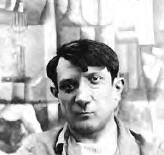Picasso's camera
dal 6/1/2006 al 19/2/2006
Segnalato da
6/1/2006
Picasso's camera
The Museum of New Art (MONA), Pontiac
Autumn 1906: Picasso announces that he has discovered photography...

Autumn 1906: Picasso announces that he has discovered photography ... "When Picasso declared that he had discovered photography, he was revealing the most profound nature of his eye. For when Picasso drew or painted, he already saw what he was still in the process of drawing or painting, on paper or on canvas; his eye projected the image because it was already prefigured in its own pupil. Very frequently, all he did was to trace out the lines of what he already saw. His discovery of photography changed everything." Fernande Olivier
"In 1906 the only contents of Picasso's studio were a day-bed, a long, rickety table, a tub and a small, rusty iron stove which was supposed to serve for cooking and heating. A dim light from a single window fell on festoons of cobwebs hanging from the ceiling. The furniture was completed by two dilapidated chairs. On top the table rested a worn box camera with a cracked lens, and nearby a glass prism." Antonina Vallentin
CUBISM IN A BOX
The box camera's cracked lens caused the facial plane in Picasso's photo-portraits to be broken themselves, and raised slightly on one side. Attributes he would soon utilize and transpose to his early sketches and preparatory drawings for the seminal LES DEMOISELLES D'AVIGNON.
Sleuthing through archives and old letters has found that the camera initially belonged to Italian futurist Gino Severini who moved to Paris in 1905. Dropped too often, the brutish Severini viewed the now-broken camera's consequent distorted photographs as “slight, humorous and mere divertissements." He easily gave up the camera to Picasso who viewed the “fractured" photographs and “broken" camera as “intriguing with possibilities." Once in his hands, as evidenced by the developed roll of film, Picasso augmented the distortion of planes with a simple prism held over the cracked lens.
The artist would sometimes further play and manipulate the negatives, adapting a century-old print-making process called cliche' verre whereby he drew and scratched designs into the emulsion and then used the resulting negative to print the photograph.
RECONSTRUCTING PICASSO
In order to re-create Picasso's original photographs, a research team headed by Dr Ake Neilsen had to teach the computer how to pick out the elements of an image that, until now, only artists have been able to recognize as important.
By giving the computer this 'aesthetic sense', Dr Neilsen from the Department of Art Sciences, was able to create a series of automated artworks with Picasso's signature effects, such as making a cubist-style picture from the seemingly ordinary found negatives.
According to Dr Neilsen the key to the new software is helping the computer recognize the important aspects of the photograph being used: "When artists draw or paint they distill all the vast detail a camera sees into a few lines or daubs of paint. We plugged digital cameras and scanners into our battery of computers and wrote software that 'looks' for the same kind of important things as Picasso did."
Image: photo by Gino Severini
Museum of New Art (MONA)
7 North Saginaw Street
Pontiac, Michigan 48342
regular hours:
12pm to 6pm Thurs-Sat or, by appointment



